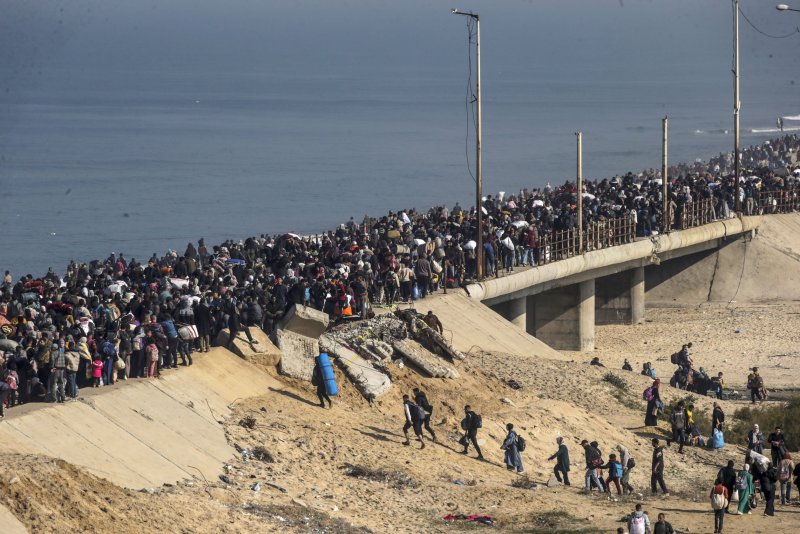Internally displaced Palestinians make their way from southern to northern Gaza on Monday along Al Rashid Road, central Gaza. According to the United Nations, at least 1.9 million people (nine in 10 people) across the Gaza Strip are displaced, many of whom have been repeatedly displaced. Photo by Mohammed Saber/EPA-EFE
Jan. 27 (UPI) — Thousands of displaced Palestinians began streaming across Gaza‘s Netzarim Corridor on Monday, returning to their homes in Gaza City and elsewhere in the north of the strip after Israel and Hamas reached an agreement on an additional hostage release later this week.
People, most of them displaced in the early phases of the 15-month-long conflict, traveled by car, donkey-cart but mostly on foot carrying their belongings in an endless column up the Al-Rashid Road which runs virtually the length of Gaza’s western side, much of it hugging the coast of the eastern Mediterranean Sea.
Israeli forces opened the crossing to pedestrians at 7 a.m. local time and to cars two hours later after massive queues built up after Jerusalem blocked Palestinians from returning to the north Sunday, alleging Hamas had violated the cease-fire agreement between the two sides.
Earlier, two people were killed and nine injured after Israeli troops opened fire on the restive crowd officials at the nearby Al-Awda Hospital said.
Israel Defense Forces acknowledged the incident on its account on X, but insisted its troops had fired warning shots only at advancing groups of suspects who “posed a threat.”
“The IDF is determined to fully maintain the terms of the agreement in order to return the hostages. The IDF is prepared for any scenario and will continue to take any necessary actions to thwart any immediate threat to IDF soldiers,” the IDF said.
The dispute was triggered by Hamas’ failure to include a civilian — Arbel Yehud — among the four hostages freed Saturday, as called for under the terms of its agreement with Israel.
Israel relented on its pledge to block Palestinians’ passage back to the North after Hamas provided evidence Yehud was alive and Qatar, which has been acting as a mediator between the sides, announced an early unscheduled release of Yehud, Agam Berger, a female soldier, and an unnamed male hostage, set for Thursday, ahead of the release of three more hostages on Saturday.
The office of Israeli Prime Minister Benjamin Netanyahu said in a post on X that it had also received a list of the status of the remaining hostages due to be released during the first six-week phase of the agreement.
However, the decision to allow Palestinians to return to their home was slammed by his former far-right national security minister, Itamar Ben Gvir, who said it was yet another shameful consequence of an ill-thought-out cease-fire agreement.
“The opening of the Netzarim highway this morning and the entry of tens of thousands of Gazans into the northern Gaza Strip are images of Hamas’ victory and another humiliating part of the reckless deal,” he wrote in a post on X.
“This is not what ‘complete victory’ looks like — this is what complete surrender looks like. The heroic IDF soldiers did not fight and give their lives in the Strip to make these images possible. We must return to war — and destroy!”
